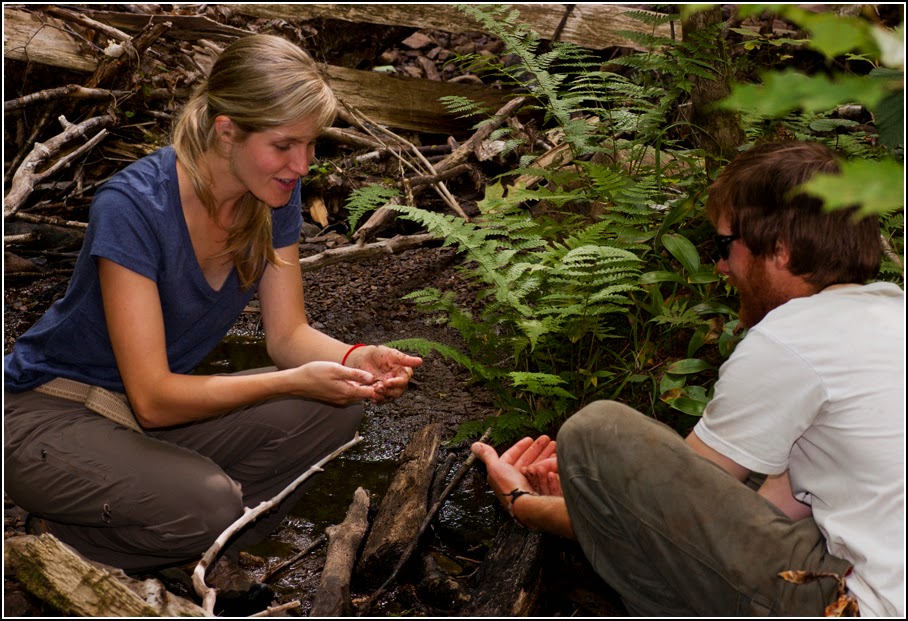After the excitement of the Brown Pelican last Friday, the weekend was far from over and Laura and I had ambitious plans to drive north and look for a few target herp species.
The first target was Eastern Massasauga so Laura and I headed north to the Gravenhurst area to see what we could turn up. There we met up with herper extraordinaire Patrick Moldowan, a close friend of both of us who we went to university with in Guelph.
It was a beautiful sunny day as we started out - good weather for Massasaugas! Throughout the morning we checked many excellent locations for them, but did not have any luck. Perhaps it was due to the time of year - by now, the rattlesnakes should have all given birth so there is just not the same need for the females to thermo-regulate. Because of that, the 'saugas were proving tough to find!
Our first herp of the day was this Northern Brownsnake under a flat rock. It would prove to be the only snake of the day found by flipping rocks, a herping technique proving more futile by the minute as the temperature rose. It was simply too hot out for herps to be under rocks.
 |
| Dekay's Brownsnake |
We approached an area where I had seen about a dozen separate rattlesnakes over the years. In a clearing was a large flat rock, perhaps 6 feet in diameter, propped up in such a way that it created a deep crevice reaching a ways underground. It had been a favoured haunt of rattlesnakes in the past, and today was no different!
 |
| Eastern Massasauga |
It was a female Eastern Massasauga, looking quite deflated as she had recently given birth. I find that Eastern Massasaugas are often quite docile, just sitting quietly and minding their own business. It is too bad that rattlesnakes get such a bad rap, especially this species in Ontario which averages less than 2 feet in length full grown and which will not bite unless provoked.
 |
| Eastern Massasauga |
It gave off a few few warning buzzes as we took photos, just to let us know to keep our distance.
 |
| Eastern Massasauga |
The rest of the afternoon was a bit slow for herps. We were able to see several Five-lined Skinks, a neonate Northern Ribbonsnake, a few Eastern Gartersnakes (normally surprisingly uncommon in this area), and a beautiful Northern Watersnake. Midland Painted Turtles were seen occasionally basking at the edges of some of the wetlands and we saw about 7 amphibian species.
.jpg) |
| Patrick and Laura with a watersnake |
The following day, Laura and I drove up to Algonquin to meet up with Patrick once again. He is stationed at the Wildife Research Station as he completes field work with Painted Turtles for his Master's degree. We had a great time paddling, swimming, and checking out some lakes that are not accessible to the public. The highlight for me though was becoming re-acquainted with the Northern Two-lined Salamander, a "lifer" for Laura.
 |
| Northern Two-lined Salamander - Algonquin |
In Ontario, Northern Two-lined Salamanders are found in the southern Canadian Shield region from Georgian Bay in the west to the Ottawa region in the east. They are one species that is probably far more common than what is known in central Ontario.
 |
| Northern Two-lined Salamander - Algonquin |
Northern Two-lined Salamanders inhabit cool, moderately to fast flowing rocky streams. They are closely associated with these streams and rarely venture too far from the banks during most of the year. In the summer they may travel a few hundred metres from their home stream to forage and are occasionally seen in the surrounding woodlands. Most of the year however, they are found under partly submerged rocks in the streams.
 |
| Two-lined Salamandering |
 |
| Northern Two-lined Salamander - Algonquin |
We found close to 10 Northern Two-lined Salamanders over the course of an hour or so. In my experience they can be very skittish and tough to photograph, however this one individual was more "obliging" than most.
 |
| Northern Two-lined Salamander - Algonquin |
It was another great weekend with some fantastic herps and awesome company!
















.jpg)








.jpg)






















.jpg)




